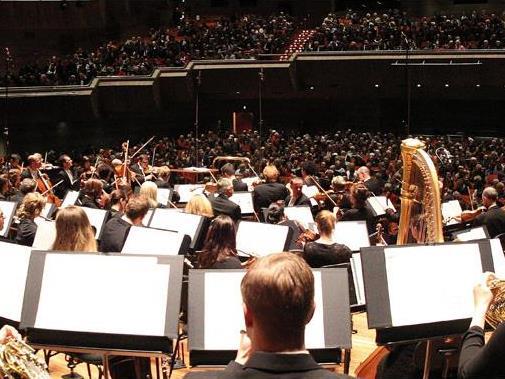Explorations of ‘The Big Divide’ continued with the case for Wagner being put most persuasively by dramatic soprano Lisa Gasteen and the Melbourne Symphony Orchestra under the baton of Asher Fisch.
In a pre-concert discussion/interview, Asher Fisch responded to questions posed by Sir Nicholas Kenyon, Managing Director of London’s Barbican Centre. Although they had already covered some of the Brahms versus Wagner ground individually in earlier sessions, together they made a highly informative and entertaining duo. Again Wagner’s limited keyboard skills were discussed and the fact that he never bothered with any exercises in counterpoint. Seeing that his first symphony was something of a flop, and remains largely unplayed, he declared the form obsolete.
The first reinvention of his style came with Der fliegende Holländer. Tannhäuser fits into this period. If the symphonic form eluded Wagner, his Overture to Tannhäuser shows that he certainly knew how to use a symphony orchestra. Asher Fisch moulded the MSO so carefully and compellingly that the glories of the music were on full display. From the initial slow brass and wind chords, layers of orchestral texture were built up to stately, triumphant climaxes. Despite some problems with initiating a clean attack from some of the brass, the horns rose to the occasion with some truly impressive playing in this and other items on a very horn oriented program. The shaping and blending of the string sound in their various sections, in different combinations and as a whole was splendid. Conducting without a score for most of the evening, Fisch gave his full attention to eliciting the most coherent and unified sweep of musical expression possible.
The chronological sequence of the program was disrupted with the excerpts from Götterdämmerung, by which time Wagner had well and truly mastered his new modes of expression. Between composing the second and third acts of Siegfried there is a gap of twelve years and a revolution in Wagner’s approach to music. His use of chromaticism, which originally caused such controversy, is now so familiar to modern audiences that it is hard to see what the fuss was all about. It is a key part of the appeal, one might say.
The biggest attraction for the evening for many was undoubtedly the appearance of Lisa Gasteen in her signature role of Brünnhilde. Fisch had stated earlier that, after working with her in the last Adelaide production of ‘The Ring’, she would always be his Brünnhilde. The ‘Immolation Scene’ offers considerable challenges in the concert hall. With a full symphony orchestra in full cry on the stage rather than tucked into the pit, or even under the stage as in Bayreuth, it is almost impossible for the soprano to cut through the sheer weight of sound. It is a twenty-minute test of vocal power and stamina. From the moment she entered, dressed in a gown that evoked a medieval heroine of warrior strength, Gasteen established a dignified dramatic presence. The steely grey sheen of the outer garment and a central panel with its suggestion of crimson fire was an understated and entirely appropriate way of establishing her character. Those who adore her voice (and I am among them) were thrilled to hear that idiosyncratic, clotted cream Gasteen timbre. Strength and beauty throughout the registers and ringing top notes were all there on Saturday night. There were also, however, some less steady moments and a certain tightness on the fiendishly high notes towards the end. Gasteen lived the part and invested every phrase with meaning, embodying Brünnhilde’s noble spirit.
On the basis of this performance it was easy to understand Asher Fisch’s enthusiasm for the first five minutes of Die Meistersinger, with its very difficult horn solo. As with the first half of the program, his search for free flowing musical expressiveness was achieved in this and in the excerpts from Parsifal. The lovely oboe solo towards the end of Parsifal was one of several fine solos from various members of the orchestra throughout the evening, but it was in the orchestra as an integrated, responsive entity that most satisfaction was to be found.
Rating: 4 stars
Melbourne Symphony Orchestra
Conductor Asher Fisch
Soprano Lisa Gasteen
Wagner – Tannhäuser: Overture
Wagner – Götterdämmerung: ‘Siegfried’s Funeral Music’, ‘
Wagner – Die Meistersinger von Nürnberg: Prelude, ‘Dance of the Apprentices’, and Prelude to Act 3
Wagner – Parsifal: Prelude, and ‘Good Friday Spell’
Arts Centre Melbourne, Hamer Hall
19 October





